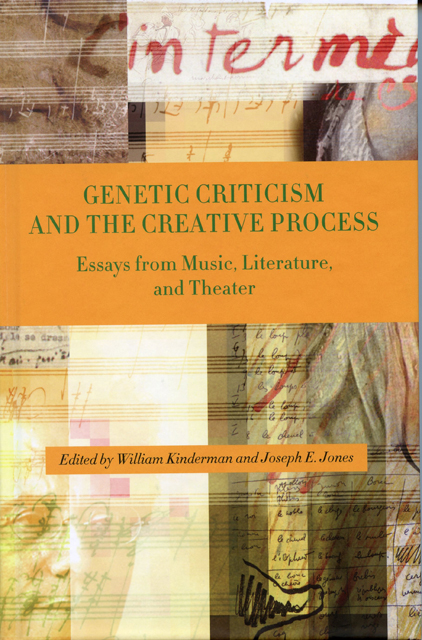Book contents
- Frontmatter
- Contents
- Acknowledgments
- Genetic Criticism and the Creative Process
- 1 Texts, Variants, and Variations: Evolving Contexts in Literature and Theater
- 2 Genetic Processes in Music: From Beethoven to Leroux
- 1 From Varieties of Genetic Experience to Radical Philology
- 2 Variant and Variation: Toward a Freudo-bathmologico-Bakhtino-Goodmanian Genetic Model?
- 3 The Genetic Record of a Voice: Variants in Barthes's Le Plaisir du texte
- 4 Can Genetic Criticism Be Applied to the Performing Arts?
- 5 “The hardy Laurel”: Beckett and Early Film Comedy
- 6 From Melodic Patterns to Themes: The Sketches for the Original Version of Beethoven's “Waldstein” Sonata, Op. 53
- 7 From Conceptual Image to Realization: Some Thoughts on Beethoven's Sketches
- 8 The Process within the Product: Exploratory Transitional Passages in Beethoven's Late Quartet Sketches
- 9 “They Only Give Rise to Misunderstandings”: Mahler's Sketches in Context
- 10 A Study of Richard Strauss's Creative Process: Der Rosenkavalier's “Presentation Scene” and “Schlußduett”
- 11 Genetic Criticism and Cognitive Anthropology: A Reconstruction of Philippe Leroux's Compositional Process for Voi(rex)
- Afterword
- Contributors
- Index
6 - From Melodic Patterns to Themes: The Sketches for the Original Version of Beethoven's “Waldstein” Sonata, Op. 53
Published online by Cambridge University Press: 02 March 2023
- Frontmatter
- Contents
- Acknowledgments
- Genetic Criticism and the Creative Process
- 1 Texts, Variants, and Variations: Evolving Contexts in Literature and Theater
- 2 Genetic Processes in Music: From Beethoven to Leroux
- 1 From Varieties of Genetic Experience to Radical Philology
- 2 Variant and Variation: Toward a Freudo-bathmologico-Bakhtino-Goodmanian Genetic Model?
- 3 The Genetic Record of a Voice: Variants in Barthes's Le Plaisir du texte
- 4 Can Genetic Criticism Be Applied to the Performing Arts?
- 5 “The hardy Laurel”: Beckett and Early Film Comedy
- 6 From Melodic Patterns to Themes: The Sketches for the Original Version of Beethoven's “Waldstein” Sonata, Op. 53
- 7 From Conceptual Image to Realization: Some Thoughts on Beethoven's Sketches
- 8 The Process within the Product: Exploratory Transitional Passages in Beethoven's Late Quartet Sketches
- 9 “They Only Give Rise to Misunderstandings”: Mahler's Sketches in Context
- 10 A Study of Richard Strauss's Creative Process: Der Rosenkavalier's “Presentation Scene” and “Schlußduett”
- 11 Genetic Criticism and Cognitive Anthropology: A Reconstruction of Philippe Leroux's Compositional Process for Voi(rex)
- Afterword
- Contributors
- Index
Summary
Melodic patterns fill Beethoven's earliest sketches for the first movement of his Piano Sonata in C Major, Op. 53. The entirety of the sketches for the “Waldstein” Sonata are found in the Landsberg 6 sketchbook, on pages 107 and 120–45. Although there was certainly a great deal of compositional planning for the sonata that is not documented in the sketchbook, it is instructive that Beethoven's nascent sketches so prominently featured patterns. And there are many ways that these patterns open up creative space for the sonata's themes.
Example 6.1 transcribes the sketches found on page 107, which are commonly considered to be the earliest for the first movement of the “Waldstein” Sonata. One might expect the first sketch to provide the opening theme to the movement—measures on which the rest of the musical material of the movement will emanate. However, this example does not suggest a composer preoccupied with drafting the first measures of a new sonata. The keyboard exercises in this example probably precede Beethoven's invention of any particular theme in the “Waldstein,” and one is hard pressed to explain their exact formative role in this sonata.
Gustav Nottebohm, Barry Cooper, and Katherine Syer all present intriguing reasons to treat the scalar exercises of example 6.1 as a starting point. Nottebohm writes, “It is reasonable to assume that the attention to keyboard technique and this particular type of exercise had some infl uence on the brilliant passage-work of a piano composition started shortly after these sketches were written.”1
Barry Cooper balances the possibility that these exercises “may be of no significance” to the “Waldstein” with the chance that they are the work's “earliest possible sign.”2 He points to the fact that the exercises are mostly in C major and 4 4 time as a possible link to the sonata's first movement. In addition, he suggests that the presence of one pattern in E minor (lines 11–12) may offer evidence that E will be an important subsidiary key in the upcoming work. According to both authors, these patterns inspire some of the most general decisions for the sonata: key, level of virtuosity, and instrument.
Katherine Syer draws attention to the fact that these patterns appear on the first page of eighteen-staff paper in the “Eroica” sketchbook, whereas the previous pages are all on sixteen-staff paper.
- Type
- Chapter
- Information
- Genetic Criticism and the Creative ProcessEssays from Music, Literature, and Theater, pp. 95 - 107Publisher: Boydell & BrewerPrint publication year: 2009
- 1
- Cited by



